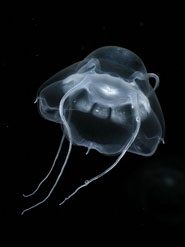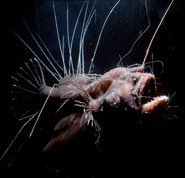|
Home > Ocean > Ocean Zones > Midnight Zone
Understanding Ocean Zones: Midnight Zone
|

Narcomedusae jelly
|
The deepest, darkest
regions of the ocean are found from about 2000 meters down to the
sea floor. It is a realm of perpetual darkness, where even the faintest
blue tendrils of sunlight cannot penetrate. It has been called the
“Midnight Zone” because it is continually plunged in utter
blackness, even when the brightest summer sun is perched high above
the surface, there is no “daytime” here. Life that exists
in the midnight zone relies indirectly on the benefits of sunlight;
organisms thriving in the sunny upper layers of the sea die their
eventual deaths and rain down upon the sea floor a steady flow of
organic nutrients to feed the masses living at or near the bottom.
The organic “rainfall” includes dead microscopic organisms,
such as phytoplankton and dinoflagellates, sinking downward, fecal
pellets of fish and mammals, and carcasses of larger organisms sinking
down to the sea bed. Those creatures that do not feed directly on
the “leftovers” raining down from above, usually prey
upon those that do. Many of the creatures thriving in the deep sea
have taken on fascinating, gruesome and horrifying visages and proportions,
developing special adaptations to surviving in this harsh environment.
The deep sea still remains largely unexplored. The
extreme hydrostatic pressure of the overlying water at depths of 2000
meters and more demand technologies that can safely withstand the
cold, crushing waters of the deep. The technologies used to explore
the inner space of the deep sea have only recently been developed
in the last 30 years, and are just now becoming more widely available
to a non-civilian community of scientific explorers. There have been
 many, manned “missions” in the last 30 years in various
submersible crafts to get a glimpse of the mysteries that lay at the
bottom of the sea, but we have only begun to scratch the surface.
It is estimated that less than less than one-millionth of the sea’s
darkness has been explored and seen by human eyes. It is truly a frontier
in its infant stages of human discovery. many, manned “missions” in the last 30 years in various
submersible crafts to get a glimpse of the mysteries that lay at the
bottom of the sea, but we have only begun to scratch the surface.
It is estimated that less than less than one-millionth of the sea’s
darkness has been explored and seen by human eyes. It is truly a frontier
in its infant stages of human discovery.
The average depth of the ocean is over two
miles deep. It is estimated that of all the habitable regions on earth,
including dry land and the vast oceans, that the deep sea regions
make up 97% of habitable living space
on the planet. If you add up all the people living today with all
the other living organisms on land (plants, insects, animals, microorganisms),
we account for less than one percent of all the biomass (the total
mass of living organisms in a given environment) on the entire planet.
Truly, the most successful habitat on earth, given the biomass it
supports, is the deep sea. The bottom line is, as creepy and foreign
as those bizarre deep creatures are to us, there are more of them
living on this planet than us! The next zone is the trench zone....

|

